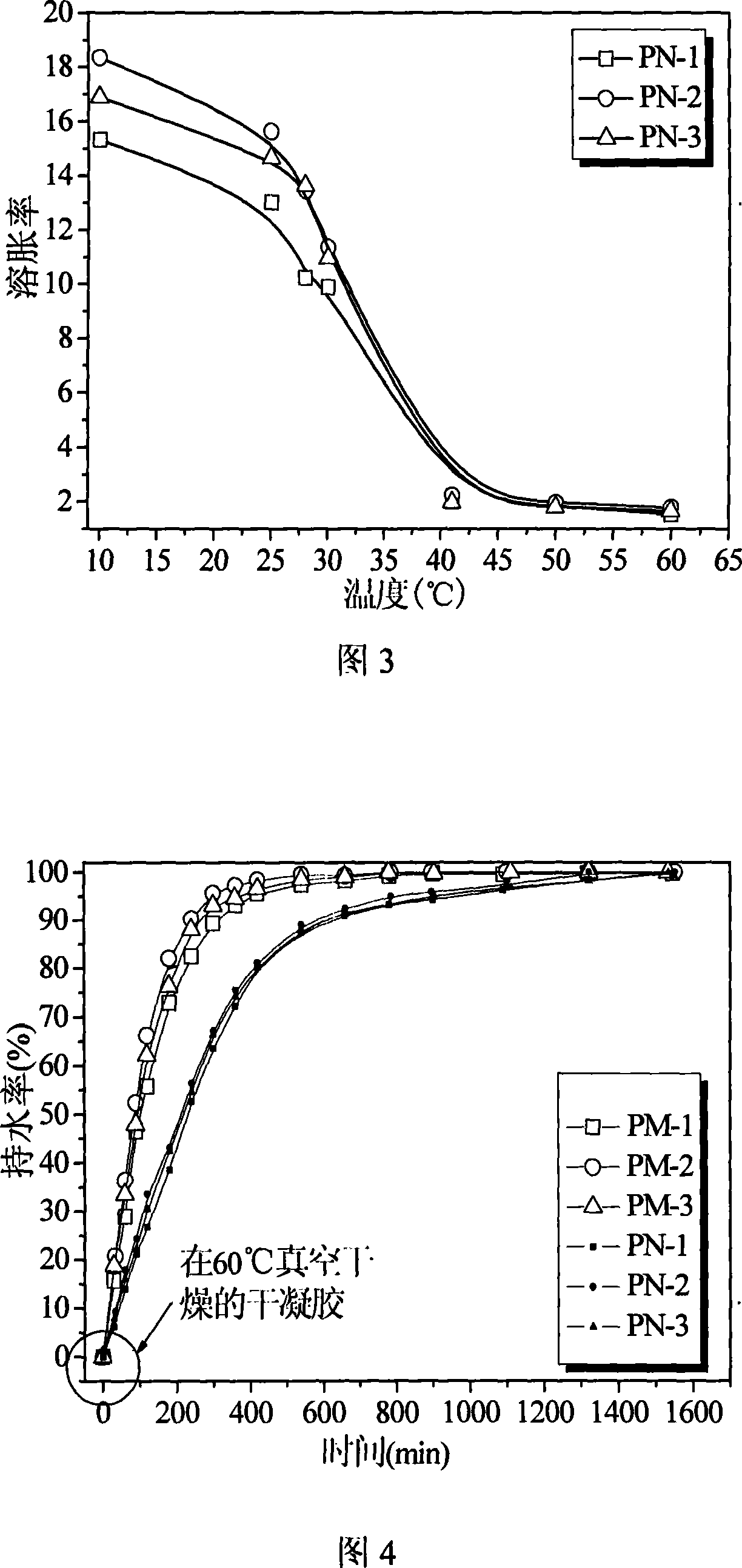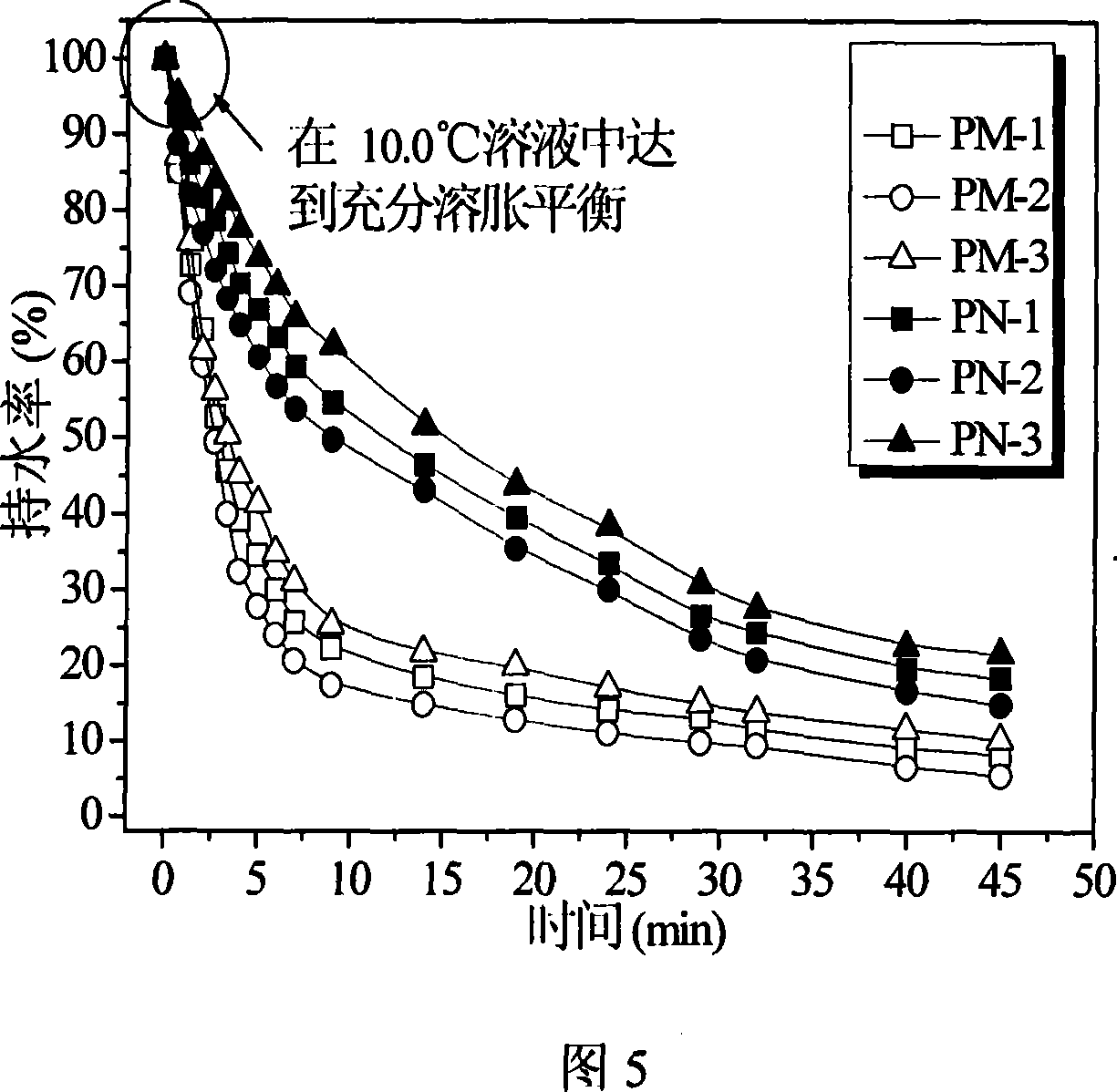N-isopropyl acrylamide thermosensitive aquagel and its microwave radiation preparing method
A technology of isopropylacrylamide and heat-sensitive hydrogel, which is applied in the field of preparation of intelligent polymer materials, can solve the problems of reducing sensitivity, hydrogel pollution, and difficulty in dissolution of pore-forming agents, and achieves the improvement of specific surface area and Capacity, the effect of increasing the saturation swelling rate and
- Summary
- Abstract
- Description
- Claims
- Application Information
AI Technical Summary
Problems solved by technology
Method used
Image
Examples
Embodiment 1
[0028] 10mL acetone, 2.0000g NIPAAm, 0.050g cross-linking agent (BIS-A) and 0.1mmol initiator (AIBN) were added into the round bottom flask successively, and nitrogen was introduced to exhaust oxygen for 70min (introduction volume was 5.6L); then The solution was transferred to a cylindrical microreactor, placed in a microwave workstation, and a microwave with a frequency of 2450MHz and a power of 30W was applied and the reaction temperature was controlled at 70°C (ie, the set temperature). During the microwave action, the reaction system is in the reaction stage of continuous heating under the action of 30W power, and reaches the set reaction temperature of 70°C in 60s. Then the microwave enters the constant temperature reaction stage, and the temperature of the reaction solution is kept at 70°C. This process lasts for 60 minutes and then stops, and the reaction ends at this time. The follow-up treatment is the same as the common water bath method, and the synthesized hydroge...
Embodiment 2
[0030] 12mL acetone, 2.0000g NIPAAm, 0.023g cross-linking agent (BIS-A) and 0.1mmol initiator (AIBN) were added into the round bottom flask successively, and nitrogen gas was introduced to exhaust oxygen for 70min (introduction volume was 5.6L); then The solution was transferred to a cylindrical microreactor, placed in a microwave workstation, and a microwave with a frequency of 2450 MHz and a power of 100 W was applied and the reaction temperature was controlled at 80° C. (ie, the set temperature). During the process of microwave action, the reaction system is in the reaction stage of continuous heating under the action of 100W power, and reaches the set reaction temperature of 80°C in 53s. Then the microwave enters the constant temperature reaction stage, and the temperature of the reaction solution is kept at 80°C. This process lasts for 30 minutes and then stops, at which point the reaction ends. The follow-up treatment is the same as the common water bath method, and the ...
Embodiment 3
[0032] 14mL acetone, 2.0000g NIPAAm, 0.050g cross-linking agent (BIS-A) and 0.1mmol initiator (AIBN) were added into the round bottom flask successively, and nitrogen gas was introduced to exhaust oxygen for 70min (introduction volume was 5.6L); then The solution was transferred to a cylindrical microreactor, placed in a microwave workstation, and a microwave with a frequency of 2450 MHz and a power of 200 W was applied and the reaction temperature was controlled at 90° C. (ie, the set temperature). During the process of microwave action, the reaction system is in the reaction stage of continuous heating under the action of 200W power, and reaches the set reaction temperature of 90°C in 45s. Then the microwave enters the constant temperature reaction stage, and the temperature of the reaction solution is kept at 90°C. This process lasts for 60 minutes and then stops, and the reaction ends at this time. The follow-up treatment is the same as the common water bath method, and th...
PUM
| Property | Measurement | Unit |
|---|---|---|
| specific surface area | aaaaa | aaaaa |
Abstract
Description
Claims
Application Information
 Login to View More
Login to View More - R&D
- Intellectual Property
- Life Sciences
- Materials
- Tech Scout
- Unparalleled Data Quality
- Higher Quality Content
- 60% Fewer Hallucinations
Browse by: Latest US Patents, China's latest patents, Technical Efficacy Thesaurus, Application Domain, Technology Topic, Popular Technical Reports.
© 2025 PatSnap. All rights reserved.Legal|Privacy policy|Modern Slavery Act Transparency Statement|Sitemap|About US| Contact US: help@patsnap.com



